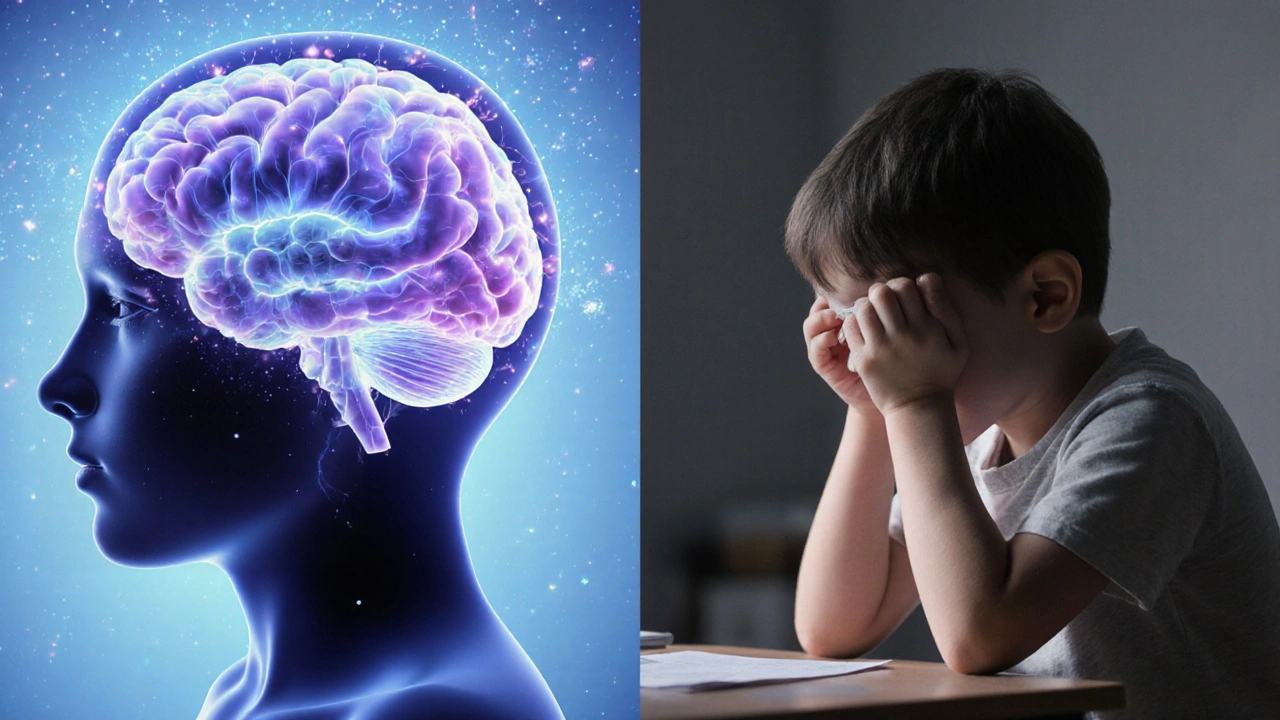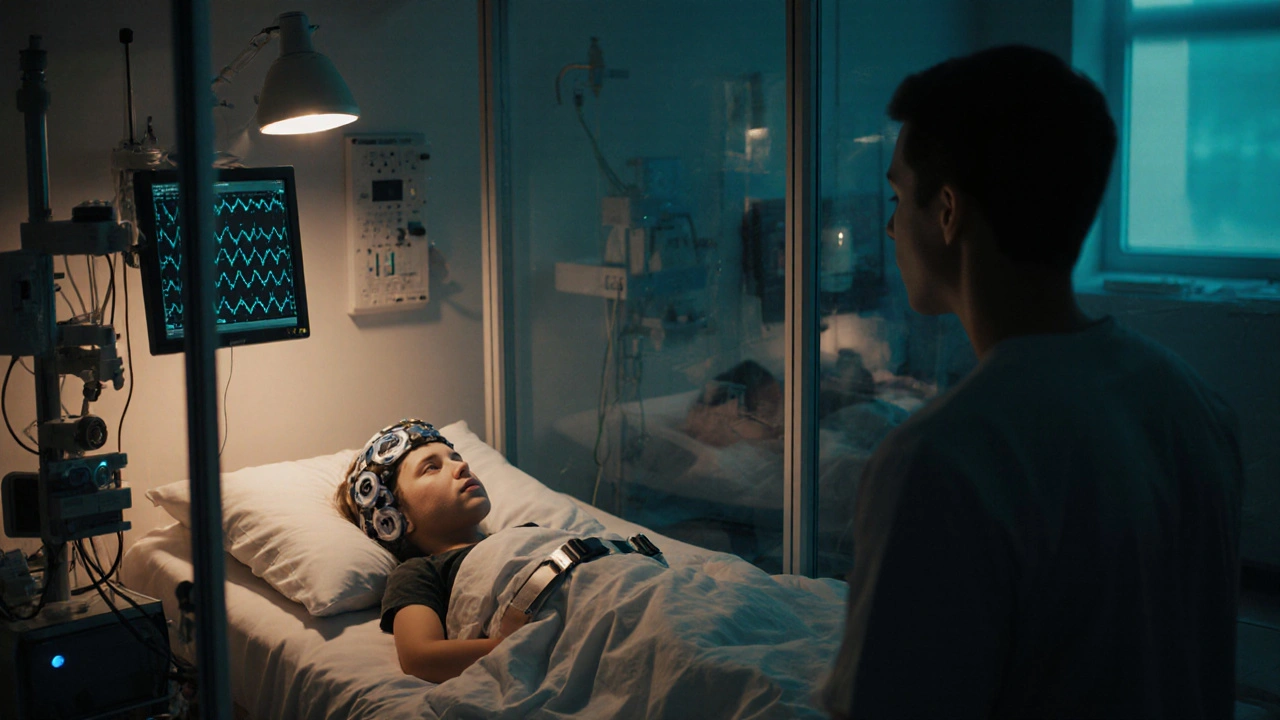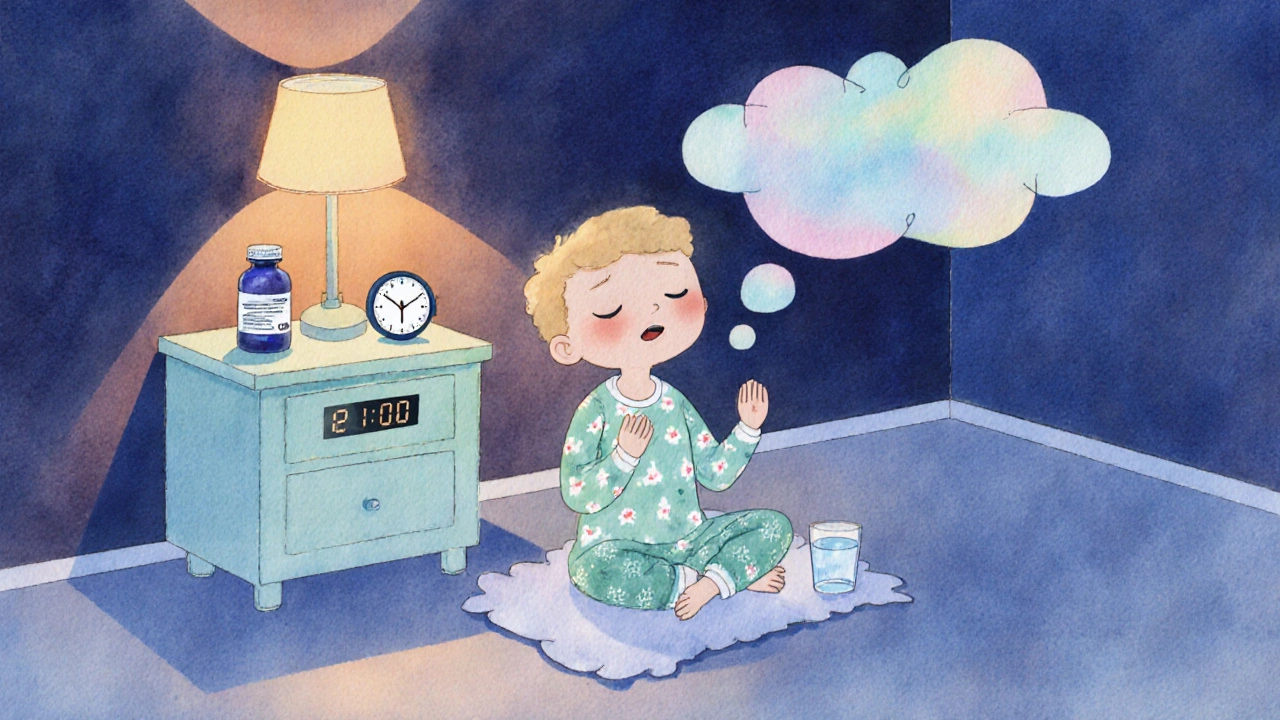REM Sleep and ADHD: How They’re Connected
 Oct, 13 2025
Oct, 13 2025
REM Sleep Calculator for ADHD
REM Sleep Calculator
Your estimated REM sleep duration:
Key Takeaways
- REM sleep is crucial for brain development and emotional regulation.
- Children and adults with ADHD often show reduced REM duration and fragmented REM patterns.
- Neurotransmitters like dopamine and melatonin link sleep architecture to ADHD symptoms.
- Polysomnography can reveal sleep‑stage abnormalities that guide treatment.
- Improving sleep hygiene, adjusting stimulant timing, and, when needed, melatonin supplementation can boost REM and ease ADHD challenges.
Improving REM sleep is a practical step anyone dealing with ADHD can try.
What is REM Sleep?
REM sleep is a stage of sleep characterized by rapid eye movements, vivid dreaming, and a brain activity pattern similar to wakefulness. During REM, the brain consolidates emotional memories, regulates mood, and supports executive functions. It makes up about 20‑25% of a typical night, with the first episode occurring 90 minutes after falling asleep and lengthening toward morning.
REM follows cycles of non‑REM (N1‑N3) in the sleep architecture. The alternating pattern-NREM → REM-is called the sleep cycle, lasting roughly 90‑110 minutes. Disruptions to this cycle can shrink REM windows and disturb the brain processes that depend on them.
What is Attention Deficit Hyperactivity Disorder (ADHD)?
ADHD is a neurodevelopmental condition marked by inattention, hyperactivity, and impulsivity that interfere with daily life. It affects roughly 5‑7% of school‑age children worldwide and often persists into adulthood. Core brain regions involved include the prefrontal cortex and basal ganglia, which rely heavily on dopamine signaling for attention and self‑control.
Standard treatment consists of stimulant medications (e.g., methylphenidate, amphetamine) that boost dopamine, behavioral therapy, and lifestyle adjustments such as diet and exercise.

The Science Linking REM Sleep and ADHD
Multiple studies using polysomnography have shown that people with ADHD spend less time in REM and experience more fragmented REM episodes compared with neurotypical peers. One 2022 sleep‑lab investigation of 124 children aged 7‑12 reported an average REM reduction of 16 minutes per night and a 30% increase in REM awakenings.
The connection appears to run through neurotransmitters. Dopamine regulates both attention pathways and REM generation. Low dopaminergic tone, a hallmark of ADHD, can blunt the REM drive, leading to shorter, less restorative REM bouts.
Conversely, melatonin is the hormone that cues the body to start the sleep cycle. Children with ADHD often exhibit delayed melatonin onset, pushing the whole sleep schedule later and compressing REM time.
These biochemical shifts intertwine with the circadian rhythm, the internal clock that orchestrates sleep‑wake timing. Misaligned circadian signals compound REM loss, creating a feedback loop that aggravates inattention and hyperactivity.
How REM Deficits Manifest in ADHD Symptoms
- Impaired emotional regulation: REM supports the processing of emotional memories. Inadequate REM can heighten irritability and mood swings, which mimic or worsen ADHD emotional dysregulation.
- Reduced working memory: Studies link shorter REM duration with poorer performance on digit‑span and n‑back tasks, core deficits seen in ADHD.
- Increased impulsivity: Fragmented REM leads to heightened activity in the amygdala, nudging impulsive responses.
- Difficulty with sleep‑dependent learning: Many children rely on REM to consolidate classroom lessons; lack of REM can make academic gains feel stalled.
Managing REM Sleep for Better ADHD Outcomes
Addressing REM doesn’t replace medication, but it can amplify treatment benefits. Below are evidence‑backed strategies.
1. Optimize Sleep Hygiene
- Set a consistent bedtime and wake‑time, even on weekends.
- Dim lights 30 minutes before bed; blue‑light‑blocking glasses can help protect melatonin production.
- Keep the bedroom cool (16‑19°C) and quiet to reduce stage‑shifts.
- Avoid caffeine or sugar after 2p.m., especially for younger children.
2. Time Stimulant Medication Wisely
Stimulant medication is the first‑line pharmacologic treatment for ADHD, boosting dopamine and norepinephrine activity. Common examples include methylphenidate and amphetamine salts. Because these drugs can suppress REM, timing matters. A 2021 clinical trial showed that moving the morning dose 2hours later increased nightly REM by 12%, while maintaining symptom control.
3. Consider Melatonin Supplementation
Low‑dose melatonin (0.5‑1mg) taken 30minutes before bedtime has been shown to advance sleep onset by 20‑30minutes and modestly raise REM proportion. Parents should consult a pediatrician before starting.
4. Use Behavioral Interventions
Relaxation techniques such as guided imagery or breathing exercises before sleep can reduce nighttime awakenings, allowing REM cycles to run uninterrupted.
5. Monitor with Polysomnography or Home Sleep Labs
If REM deficits appear severe, a sleep study can pinpoint abnormalities-like REM latency or arousal index-and guide targeted interventions.
Comparison: REM Sleep vs. Non‑REM Sleep
| Feature | REM Sleep | Non‑REM Sleep (Stages N1‑N3) |
|---|---|---|
| Brain activity | EEG pattern similar to wakefulness (mixed frequency) | Progressively slower waves; deep sleep shows delta waves |
| Eye movement | Rapid bursts | None |
| Muscle tone | Atonia (paralysis) | Variable; light stages have some tone |
| Dreaming | Vivid, narrative dreams | Occasional, less vivid |
| Physiological role | Emotional memory consolidation, mood regulation | Physical restoration, growth hormone release |

What to Watch For
Parents and clinicians should flag the following signs that REM loss may be worsening ADHD:
- Daytime fatigue despite adequate total sleep time
- Sudden spikes in irritability or emotional outbursts
- Decline in school performance after a period of irregular sleep
- Increasing night‑time awakenings, especially after the first REM episode
Future Directions
Research is moving toward personalized sleep‑ADHD profiles. Wearable EEG headbands could give real‑time REM estimates, letting families tweak bedtime routines on the fly. Pharmacological approaches targeting the orexin system-a driver of REM-are also under investigation for dual benefits on attention and sleep.
Takeaway Checklist
- Track bedtime, wake time, and any night awakenings for at least two weeks.
- Ask your provider about a possible melatonin trial if sleep onset is delayed.
- Review stimulant timing with your prescriber; earlier dosing may preserve REM.
- Consider a sleep study if REM fragmentation persists despite hygiene changes.
Frequently Asked Questions
Can ADHD medication completely block REM sleep?
Stimulants can reduce REM duration, especially if taken late in the day, but they rarely eliminate REM entirely. Adjusting the dosing schedule usually restores a healthier REM proportion.
Is melatonin safe for children with ADHD?
Low‑dose melatonin (0.5‑1mg) is generally considered safe for short‑term use in children, but it should be prescribed or approved by a pediatrician who monitors growth and daytime alertness.
How much REM sleep does a typical child need?
Kids aged 6‑12 usually spend 20‑25% of their total sleep time in REM, which translates to roughly 80‑100 minutes if they get the recommended 9‑11 hours of sleep.
Can improving REM sleep reduce the need for medication?
Better REM can lessen symptom severity for some, but it rarely replaces medication entirely. Think of sleep optimization as a complementary strategy that may allow lower doses.
What are the warning signs of severe REM fragmentation?
Frequent night awakenings, persistent daytime sleepiness, mood swings, and a sudden drop in school performance are red flags that merit a professional sleep evaluation.

Bryan L
October 13, 2025 AT 20:17Thanks for pulling this together; it really shines a light on something many families struggle with :)
joseph rozwood
October 24, 2025 AT 11:17This article, while well‑intentioned, glosses over the messy reality of pharmacological timing-*and* somehow pretends a simple bedtime tweak can cure deep‑seated neurochemical deficits. The prose drifts between pseudo‑scholarship and pop‑science fluff, leaving the discerning reader yearning for rigor. Honestly, it feels like an oversimplified pamphlet masquerading as a comprehensive guide. Moreover, the occasional typo ("stimulant" misspelled as "stimulents") betrays a lack of editorial oversight. If you’re seeking depth, look elsewhere.
Edwin Pennock
November 4, 2025 AT 02:17Actually, the article hits the nail on the head about timing-most people miss that nuance. The so‑called “oversimplification” is just making science accessible, which is crucial for parents who can’t parse dense journals.
Bart Cheever
November 14, 2025 AT 17:17The piece suffers from inconsistent verb tenses and runs several sentences together without proper commas, which hampers readability. A more disciplined approach to syntax would strengthen the arguments presented.
Jessica Haggard
November 25, 2025 AT 08:17While I see the grammatical concerns, the core message about sleep hygiene is vital and should not be dismissed because of stylistic glitches. Let’s focus on applying those practical tips for kids.
Alan Clark
December 5, 2025 AT 23:17i think the rem calculator is a cool tool but i wonder if it accounts for naptime in kids. also, are there any apps that sync with this?